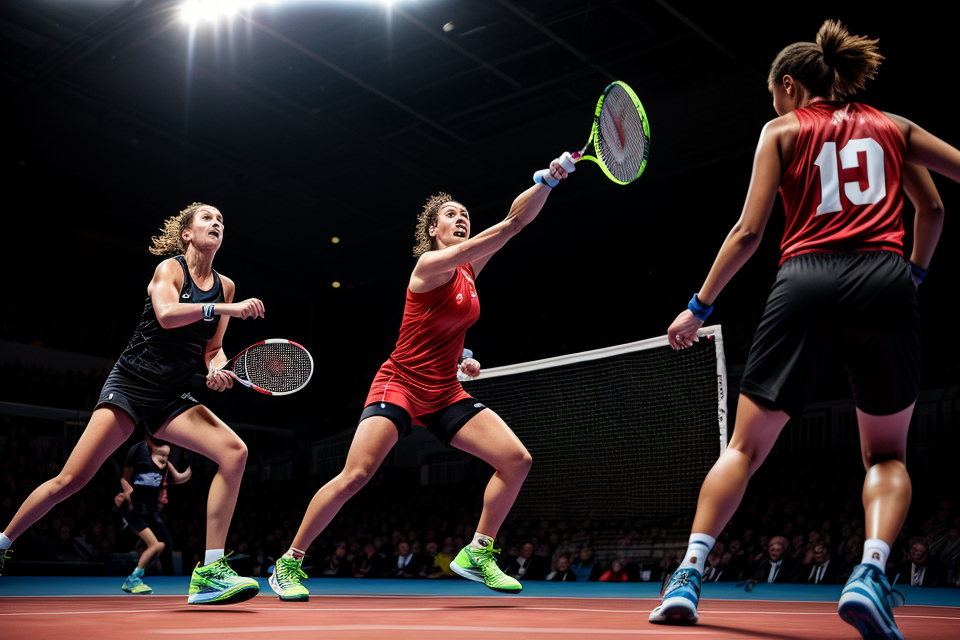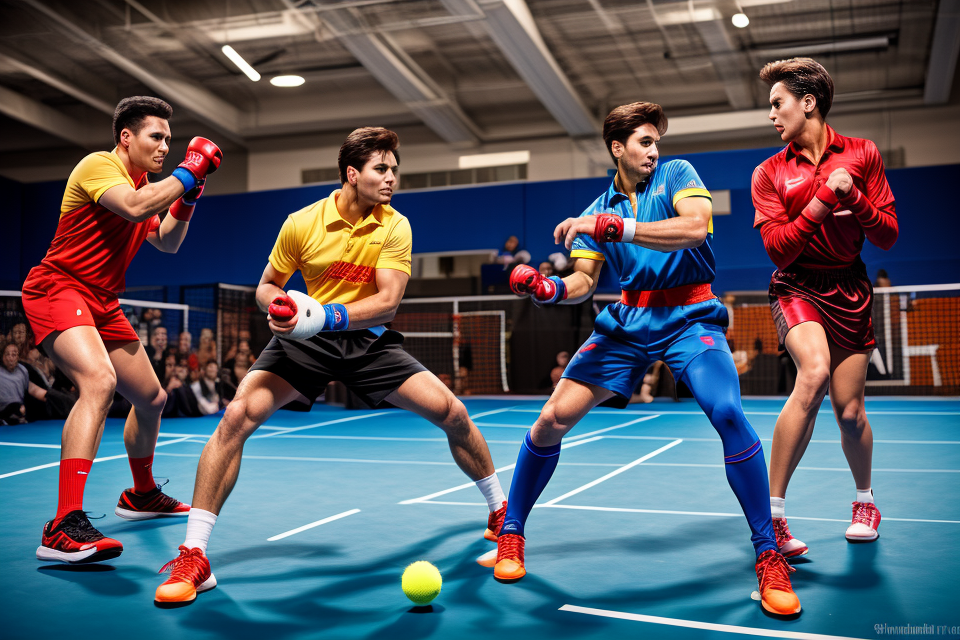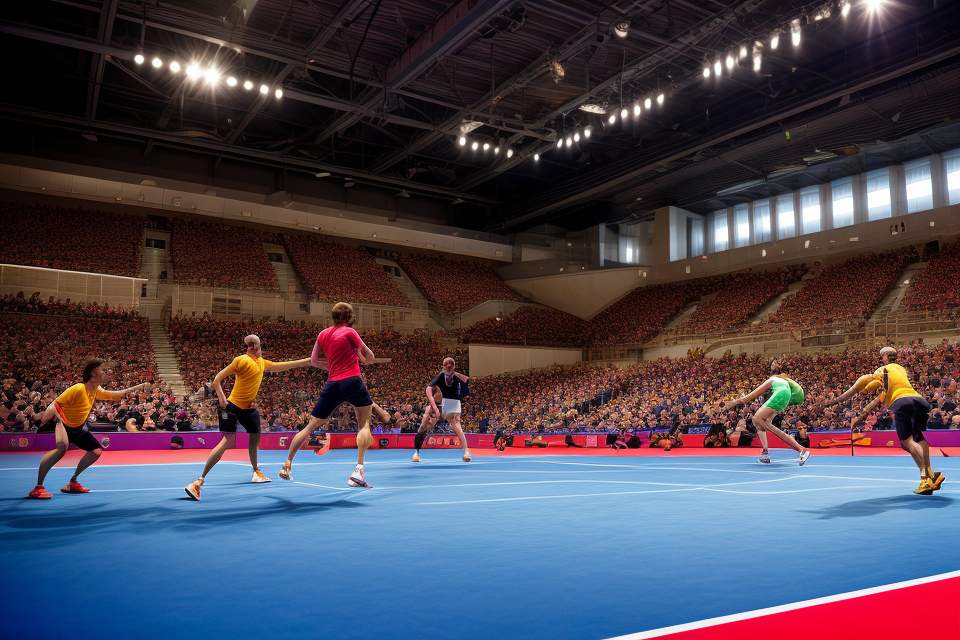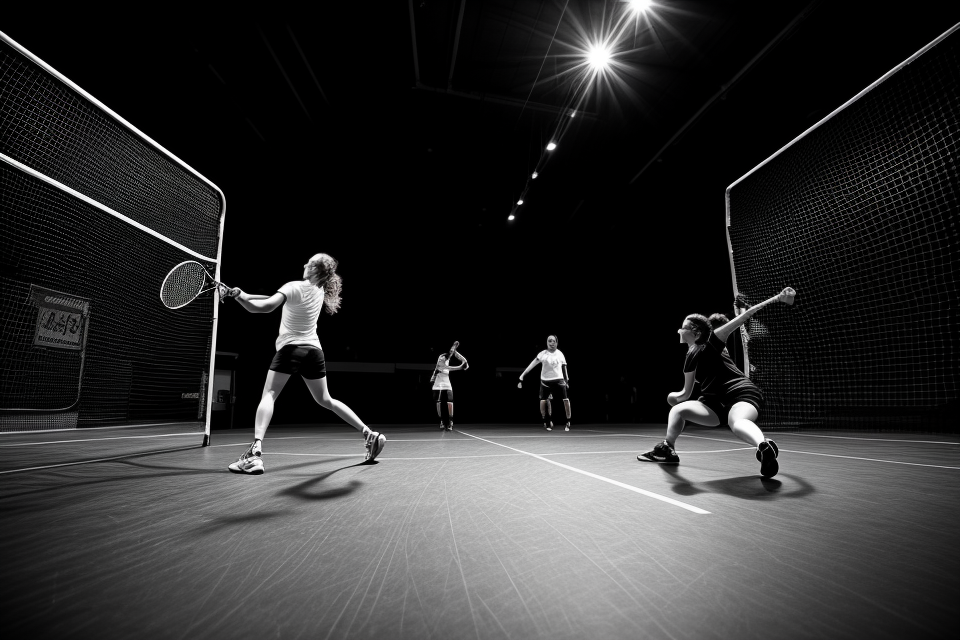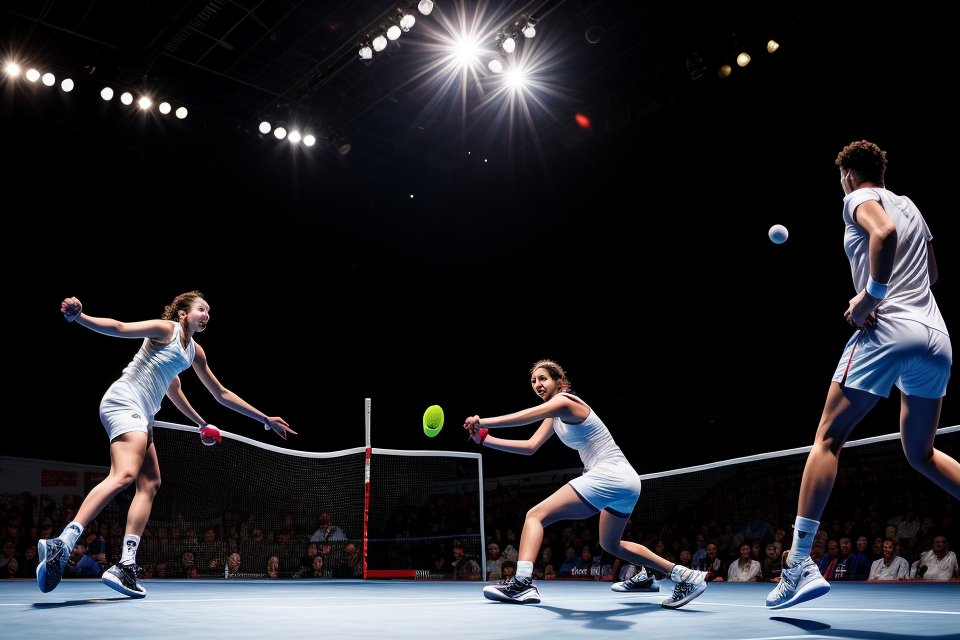Squash is a fast-paced, high-energy sport that demands exceptional physical prowess and mental agility from its players. It is often regarded as one of the most physically demanding sports, with its players engaging in intense physical activity that can last up to an hour or more. But, the question remains, is squash a high intensity sport? In this article, we will explore the intensity of squash and determine whether it can be classified as a high-impact sport. So, let’s dive in and discover the true nature of this exhilarating sport!
Squash is a high-impact sport that requires players to move quickly and change direction frequently, making it a great cardiovascular workout. The intensity of the sport depends on various factors such as the skill level of the players, the court surface, and the pace of the game. However, it is generally considered a high-impact sport due to the nature of the movements involved in playing it. Players often jump, sprint, and slide, which can put a lot of stress on the joints and muscles. Additionally, the ball itself can travel at high speeds, making it necessary for players to react quickly and move in different directions to avoid being hit. Overall, while the intensity of squash can vary, it is generally a physically demanding sport that can provide a great workout for players of all levels.
Understanding Squash as a Sport
Overview of Squash
Squash is a racket sport played by two players in a four-walled court. The objective of the game is to hit the ball in such a way that your opponent is unable to return it, resulting in a point for you. The game is played with a small, lightweight rubber ball and a squash racket.
The rules of squash are relatively simple, but the game itself can be quite complex due to the fast-paced nature and unique demands placed on the body. Players must be physically fit and possess excellent hand-eye coordination, agility, and endurance to succeed in the sport.
One of the unique aspects of squash is the fact that it is played on a small court, which makes the game even more intense. The small court size requires players to be constantly moving and adapting to their opponent’s movements, making it a high-intensity, physically demanding sport.
Additionally, squash is a non-contact sport, meaning that players cannot intentionally make contact with their opponent. This adds an extra layer of complexity to the game, as players must use strategy and finesse to outmaneuver their opponent without resorting to physical contact.
Overall, squash is a sport that requires a high level of physical fitness, mental focus, and strategic thinking. It is a sport that demands the best from its players, making it a challenging and rewarding experience for those who choose to participate.
Key Features of Squash
Court Dimensions and Equipment
Squash is played on a rectangular court measuring 18.29 meters (60 feet) long and 9.14 meters (30 feet) wide. The walls and floor of the court are made of concrete or masonry, and the ceiling is typically low, often around 6 meters (20 feet) high. Players use a small, rubber ball with a circumference of 40-43 centimeters (15.7-16.9 inches) and a weight of 160 grams (5.6 ounces). The ball is made of two layers of rubber with a small amount of hair or flocking embedded between them.
Gameplay
The objective of squash is to hit the ball in such a way that it bounces twice on the opponent’s side of the court before the opponent returns it. The player with the serve starts the point by hitting the ball diagonally to the far corner of the court. Points are scored by hitting the ball so that it passes over the net and cannot be returned by the opponent. Squash matches typically consist of five 11-point games, with a two-point advantage required for victory.
Physical Demands
Squash is a high-intensity sport that requires players to move quickly and change direction rapidly. The game involves a lot of jumping, running, and physical exertion. Players need excellent hand-eye coordination, strength, and endurance to succeed. In addition to physical fitness, squash players must also possess strong mental skills, such as focus, strategy, and mental toughness.
Skill Level and Difficulty
Squash is generally considered a challenging sport, both physically and mentally. The sport requires a high level of technical skill, including precise ball control, powerful shots, and effective movement around the court. The speed and agility required to play squash can make it difficult for even skilled players to execute shots accurately.
In conclusion, squash is a sport with several key features that contribute to its intensity and difficulty. The court dimensions, equipment, gameplay, physical demands, and skill level all contribute to the challenging nature of the sport. Whether or not squash is considered a high-impact sport will depend on the specific criteria being used to define “high-impact.”
The Physical Demands of Squash
Cardiovascular Fitness
Squash is a sport that demands a high level of cardiovascular fitness from its players. The continuous running, jumping, and changing direction during a game make it a physically demanding sport. The heart rate of a player can reach up to 90% of its maximum rate during a game, which indicates the high level of cardiovascular fitness required.
Moreover, squash is a sport that requires quick bursts of energy, as players need to cover the court quickly to reach the ball. This requires a high level of anaerobic fitness, which is the ability of the body to produce energy without using oxygen. Players need to be able to produce short bursts of energy to reach the ball and return it to their opponent.
The constant movement and changing direction during a game also require good agility and coordination. Players need to be able to move quickly and change direction without losing balance or momentum. This requires a high level of functional fitness, which is the ability of the body to perform daily activities with ease and efficiency.
Overall, squash is a sport that demands a high level of cardiovascular, anaerobic, and functional fitness from its players. To be successful in the sport, players need to have a well-rounded fitness level that allows them to perform at their best during a game.
Strength and Power
Squash is a sport that requires a high level of physical fitness, particularly in terms of strength and power. These physical attributes are essential for players to execute the rapid movements and explosive actions required on the court.
- Muscle groups targeted: Squash involves the use of several muscle groups, including the legs, core, arms, and shoulders. Players need to have well-developed leg muscles to generate power and speed when moving around the court, while a strong core helps with balance and stability. Strong arms and shoulders are necessary for hitting the ball with force and accuracy.
- Injury risks: While squash is generally considered a low-risk sport in terms of injury, the physical demands of the game can still lead to strains, sprains, and other injuries if players do not adequately prepare their bodies for the physical exertion required.
- Training regimen: To develop the strength and power necessary for squash, players should incorporate a mix of strength training exercises, cardiovascular workouts, and on-court practice. Resistance training can help build muscle mass and improve overall physical fitness, while cardiovascular exercises such as running or cycling can help players maintain endurance and improve their lung capacity.
- Mental toughness: In addition to physical strength and power, mental toughness is also a crucial component of success in squash. Players must be able to focus and maintain their intensity throughout the match, while also adapting to changing circumstances on the court. Mental toughness can be developed through targeted training and visualization exercises, as well as through a commitment to regular practice and competition.
Flexibility and Agility
Squash is a sport that requires players to have excellent flexibility and agility. These physical attributes are crucial for players to make quick movements, change direction, and hit the ball with precision.
Flexibility is an essential aspect of squash as it allows players to stretch and reach for the ball, making it easier to hit shots that require a lot of stretching and reaching. In addition, having good flexibility helps players to move quickly and change direction without getting injured.
Agility is another important aspect of squash, as it allows players to move quickly and react to their opponent’s movements. Players need to be able to change direction quickly and make split-second decisions while on the court. This requires excellent agility, which can only be achieved through regular training and practice.
Moreover, squash is a sport that requires players to move in all directions, including forwards, backwards, and sideways. This means that players need to have excellent lateral movement skills, which are developed through exercises that focus on agility and footwork.
In addition to flexibility and agility, squash also requires players to have excellent balance and coordination. These physical attributes are crucial for players to maintain their footing on the court and hit accurate shots.
Overall, squash is a sport that requires players to have excellent physical attributes, including flexibility, agility, balance, and coordination. These physical attributes are developed through regular training and practice, and are essential for players to perform at their best on the court.
Impact on Joints and Bones
Squash is a sport that demands high levels of physical fitness and endurance from its players. The sport is played on a court with a small, heavy ball and a racquet. Players must move quickly and change direction rapidly while maintaining their balance and coordination. The physical demands of squash can have a significant impact on the joints and bones of the body.
Joint Impact
Squash is a high-impact sport that places significant stress on the joints of the body, particularly the knees, ankles, and hips. The repetitive motions involved in squash, such as running, jumping, and changing direction, can lead to joint pain and inflammation over time. In addition, the impact of the ball against the racquet can cause shockwaves to travel up the arm, increasing the risk of injury to the shoulder joint.
Bone Impact
Squash can also have a significant impact on the bones of the body, particularly the spine and head. The rapid changes in direction and sudden stops can put a strain on the spine, increasing the risk of back injuries. In addition, the fast-paced nature of the sport can lead to head injuries if players collide with each other or the wall of the court.
Injury Prevention
To prevent joint and bone injuries in squash, it is important to maintain proper form and technique during play. This includes maintaining proper posture and alignment, using proper footwork, and avoiding sudden or jerky movements. In addition, players should take regular breaks during matches to stretch and rest their joints and bones. Finally, wearing appropriate footwear and using protective gear, such as a mouthguard, can help reduce the risk of injury.
Metabolic Equivalent of Task (MET) Study
How MET is Measured
When evaluating the intensity of a sport or physical activity, one commonly used metric is the Metabolic Equivalent of Task (MET). The MET system measures the energy expenditure of an individual while performing a specific task, and it is expressed in terms of the energy expended per kilogram of body weight per hour.
The MET value is calculated by multiplying the total energy expenditure (in kilojoules) by a factor of 3.5, which is the amount of energy expended per kilogram of body weight per hour. For example, if a person weighs 70 kilograms and burns 500 kilojoules during a squash game, their MET value would be 70 x 3.5 = 2450 METs.
The MET system provides a standardized way to compare the energy expenditure of different activities, allowing researchers and fitness enthusiasts to determine the intensity of a particular sport or exercise. It is important to note that the MET value can vary depending on the individual’s body weight, fitness level, and other factors, such as altitude and environmental conditions.
To accurately measure MET values, researchers typically use indirect calorimetry, which involves measuring the amount of oxygen consumed by the body during exercise. This method is often used in clinical and research settings to assess energy expenditure and assess the effectiveness of exercise programs.
Overall, the MET system is a useful tool for evaluating the intensity of physical activities, including squash. By measuring the MET value, researchers and athletes can gain a better understanding of the energy expenditure associated with squash and compare it to other sports and physical activities.
Comparison of Squash to Other Sports
When comparing the intensity of squash to other sports, it is important to consider the Metabolic Equivalent of Task (MET) study. The MET system is a way to measure the energy cost of physical activities, which is calculated by multiplying the weight of the person in kilograms by the number of METs associated with the activity. One MET is equivalent to the energy expended at rest, while activities such as squash have a higher MET value, indicating a greater energy expenditure.
The MET value of squash is reported to be around 8-10, which is considered to be high-intensity. This compares to sports such as running, which has a MET value of around 7-9, depending on the speed and duration of the run. Additionally, other high-impact sports such as basketball, soccer, and rugby have MET values in the range of 8-10.
However, it is important to note that the MET value of squash may vary depending on the level of play and individual factors such as fitness level and playing style. Additionally, other factors such as the duration and intensity of the game can also impact the overall MET value of the sport.
Overall, the MET study provides a useful framework for comparing the intensity of squash to other sports, but it is important to consider individual and contextual factors when evaluating the intensity of any physical activity.
Factors Affecting MET Values
The Metabolic Equivalent of Task (MET) is a measure of the energy expended during physical activity. It is used to determine the intensity of an exercise and can be expressed in terms of the number of calories burned per minute. However, the MET value of a particular activity can be affected by several factors, including:
- Body weight: Individuals with higher body weights will burn more calories during physical activity than those with lower body weights. This is because they have more muscle mass and require more energy to move their bodies.
- Body composition: The composition of an individual’s body can also affect the MET value of an activity. For example, individuals with higher levels of muscle mass will burn more calories than those with less muscle mass, even if their overall body weight is the same.
- Activity level: The MET value of an activity can also be affected by an individual’s level of physical activity. For example, an individual who is used to running marathons will burn more calories during a run than someone who is new to running and not as physically fit.
- Intensity of the activity: The intensity of an activity can also affect the MET value. Activities that are more intense, such as sprinting or heavy weightlifting, will burn more calories than activities that are less intense, such as walking or yoga.
- Environmental factors: Environmental factors such as temperature, humidity, and altitude can also affect the MET value of an activity. For example, exercising in hot and humid conditions can increase the amount of energy needed to maintain body temperature, resulting in a higher MET value.
In summary, the MET value of an activity can be affected by several factors, including body weight, body composition, activity level, intensity of the activity, and environmental factors. These factors can all play a role in determining the intensity of an exercise and how many calories are burned during physical activity.
Analysis of Squash as a High-Intensity Sport
Factors Contributing to High Intensity
Squash is a sport that requires participants to move continuously and make rapid changes in direction. The nature of the game demands players to have excellent reflexes, endurance, and physical fitness. There are several factors that contribute to the high intensity of squash, which set it apart from other sports.
A. Physical Demands
Squash is a sport that is characterized by its high-intensity physical demands. The fast-paced nature of the game requires players to move quickly and change direction frequently. Players need to be in excellent physical condition to perform at their best, and this includes having strong cardiovascular fitness, good muscle endurance, and excellent footwork.
B. Technical Skills
In addition to physical fitness, squash also requires a high level of technical skill. Players need to be able to hit the ball with precision and accuracy, and they must also be able to move around the court quickly and efficiently. The game demands quick reflexes, excellent hand-eye coordination, and the ability to think and react quickly.
C. Mental Focus
Finally, squash is a sport that requires a high level of mental focus and concentration. Players need to be able to maintain their focus throughout the game, even when under pressure. The game demands a high level of mental toughness, and players must be able to manage their emotions and stay focused on the task at hand.
Overall, these factors contribute to the high intensity of squash, making it a sport that requires a combination of physical fitness, technical skill, and mental focus.
Criteria for Defining High-Intensity Sports
High-intensity sports are those that require significant physical exertion and can result in a higher risk of injury. The criteria for defining high-intensity sports may vary depending on the source, but generally, they include:
- Cardiovascular demand: Sports that require sustained effort and high levels of endurance are typically considered high-intensity.
- Muscle exertion: Sports that involve repetitive movements, explosive actions, or a significant amount of weightlifting are often categorized as high-intensity.
- Risk of injury: Sports with a higher risk of impact or collision are generally considered to be high-intensity.
- Technical skill: High-intensity sports may also require a high level of technical skill and precision.
It is important to note that the intensity of a sport can vary depending on the level of competition and the individual participant. Someone who is highly trained and experienced in a particular sport may find it less intense than someone who is less experienced or less physically fit. Additionally, the intensity of a sport can vary over time, with some periods being more intense than others.
Comparison of Squash to Other High-Intensity Sports
When assessing the intensity of squash as a sport, it is important to compare it to other high-intensity sports. This allows for a more comprehensive understanding of the physical demands placed on athletes and the potential impact on their bodies. Some examples of other high-intensity sports include running, basketball, and soccer.
In terms of cardiovascular fitness, squash can be compared to running. Both sports require participants to maintain a high level of endurance and can be very physically demanding. Running, however, may be considered more high-impact as it involves repetitive pounding of the feet on the ground, which can put a significant amount of stress on joints and bones.
Basketball and soccer are also high-intensity sports that require quick movements and changes in direction. However, squash may be considered more intense in terms of the stopping and starting of movements, as well as the physical contact involved. The nature of the sport requires players to move quickly and change direction frequently, which can place a significant amount of stress on the joints and muscles.
Additionally, squash involves a high level of physical contact between players, which can increase the risk of injury. This is particularly true for the legs and lower back, as players may be struck by the ball or collide with their opponents. In contrast, sports such as basketball and soccer have a lower level of physical contact, although they still involve a significant amount of running and jumping.
Overall, when comparing squash to other high-intensity sports, it is clear that it places a significant amount of physical demands on its participants. While it may not be considered as high-impact as running, it is still a physically demanding sport that requires quick movements, changes in direction, and physical contact.
The Debate: Is Squash a High-Intensity Sport?
While some individuals consider squash to be a high-intensity sport, others are less convinced. This debate is centered around the physical demands and injury risks associated with playing squash. To explore this further, let’s delve into the key factors that contribute to the intensity of squash.
Cardiovascular Endurance
One of the primary factors contributing to the intensity of squash is the demand it places on cardiovascular endurance. Squash matches can last up to 90 minutes, with players constantly moving around the court, often at a brisk pace. This level of activity requires excellent cardiovascular fitness, which is a key aspect of high-intensity sports.
Agility and Footwork
Squash players must possess exceptional agility and footwork to navigate the court effectively. The sport’s fast-paced nature means that players need to be able to change direction quickly and move in multiple planes. These movements contribute to the overall intensity of the sport, as they demand a high level of physical fitness and coordination.
Strength and Power
While squash may not require the same level of raw strength as sports like weightlifting or powerlifting, it does demand a certain level of muscular strength and power. Squash players need to be able to deliver powerful shots and move around the court with ease. This requires a well-rounded fitness program that focuses on building both strength and endurance.
Injury Risks
One aspect of the debate surrounding squash’s intensity is the potential for injury. Squash is a sport that requires explosive movements and rapid changes in direction, which can lead to muscle strains, sprains, and other injuries. While these risks are present in many high-intensity sports, they do contribute to the overall intensity of squash.
In conclusion, while the debate surrounding squash’s classification as a high-intensity sport is ongoing, there is no denying that the sport demands a high level of physical fitness and coordination. From cardiovascular endurance to agility and footwork, strength and power, and even injury risks, squash possesses many of the hallmarks of a high-intensity sport. Ultimately, whether or not squash is considered a high-impact sport may come down to individual perspectives and definitions of intensity.
The Role of Skill and Technique in Intensity
- Mastery of the Racket and Court
- Proficiency in footwork and positioning
- Control of the squash ball, utilizing spins and accuracy
- Adaptability to the ever-changing pace of the game
- Physical Conditioning and Endurance
- Aerobic capacity and anaerobic power
- Agility, speed, and reaction time
- Strength and flexibility for efficient movement
- Mental Focus and Strategy
- Reading the opponent’s playstyle and adapting accordingly
- Executing precise shots at crucial moments
- Managing stress and maintaining concentration throughout the match
- Injury Prevention and Technique
- Proper warm-up and cool-down procedures
- Ergonomic equipment and footwear
- Correction of form and technique to minimize risk of injury
- Skill and technique in squash play a crucial role in determining the intensity of the sport. A well-rounded player possesses the physical attributes, mental fortitude, and tactical acumen to excel in this demanding game. The interplay of these elements elevates squash to a high-intensity sport, challenging participants both physically and mentally.
Implications for Squash Players
- Physical demands of squash
- Running and movement patterns
- Stamina and endurance
- Agility and quickness
- Strength and power
- Mental demands of squash
- Focus and concentration
- Strategy and decision-making
- Resilience and mental toughness
- Adaptability and problem-solving
- Training and injury prevention
- Proper warm-up and cool-down
- Injury prevention exercises
- Flexibility and mobility training
- Proper equipment and technique
- Nutrition and recovery
- Balanced diet with proper nutrients
- Hydration before, during, and after play
- Adequate rest and recovery time
- Proper supplementation if necessary
- Long-term health implications
- Cardiovascular health
- Musculoskeletal health
- Neurological health
- Overall physical and mental well-being
- The benefits of playing squash
- Physical fitness and health
- Mental sharpness and cognitive function
- Social interaction and community involvement
- Personal growth and development
- Conclusion: Is squash a high-impact sport?
- Factors to consider
- Final thoughts on the intensity of squash
- Future research and development in the field.
Future Research Directions
There are several directions in which future research could explore the intensity of squash as a high-impact sport. One area of focus could be on the long-term effects of playing squash on the body, particularly in relation to the development of overuse injuries. Another area of research could investigate the physiological demands of squash, including cardiovascular fitness, muscular strength and endurance, and anaerobic capacity.
Additionally, research could be conducted to compare the intensity of squash to other high-impact sports, such as tennis and basketball, in order to determine the relative impact of each sport on the body. Furthermore, future research could explore the effectiveness of different training methods and techniques for improving performance in squash, as well as the potential benefits of incorporating other forms of exercise, such as strength training and flexibility exercises, into a squash training regimen.
Lastly, research could be conducted to investigate the impact of different squash playing surfaces, such as indoor and outdoor courts, on the intensity of the sport. This could provide valuable information for players and coaches looking to optimize their training and performance on different surfaces.
Overall, there is a wealth of potential research directions that could shed further light on the intensity of squash as a high-impact sport.
FAQs
1. What is squash?
Squash is a racket sport played by two players in a four-walled court. The aim of the game is to hit the ball in such a way that your opponent is unable to return it. It is a high-intensity sport that requires both physical and mental fitness.
2. Is squash a high-impact sport?
Yes, squash is considered a high-impact sport due to the constant movement and jumping involved in the game. Players need to be agile and quick on their feet to hit the ball accurately and make moves around the court. This results in a high level of impact on the joints and bones.
3. What are the physical demands of playing squash?
Playing squash requires good cardiovascular fitness, strength, and agility. The game involves a lot of running, jumping, and sudden changes in direction, which can put a lot of strain on the body. Players need to be fit enough to maintain a high level of intensity throughout the game, which can last up to 90 minutes or more.
4. What are the benefits of playing squash?
Apart from being a high-intensity sport, squash also has many health benefits. It is an excellent cardiovascular workout that improves heart health, increases lung capacity, and reduces the risk of obesity and other related health issues. Additionally, squash helps to build strength, improve coordination, and reduce stress levels.
5. Is squash safe for everyone?
Like any other sport, squash does come with some risks. However, it is generally considered safe for most people, including those with a history of minor health issues. That being said, it is essential to consult with a doctor before starting to play squash, especially if you have a pre-existing medical condition or injury.
6. How can I reduce the risk of injury while playing squash?
To reduce the risk of injury while playing squash, it is essential to wear appropriate footwear and clothing that provides support and comfort. Additionally, warming up before the game and stretching after the game can help to prevent injuries by preparing the muscles and joints for physical activity. It is also crucial to maintain good technique and form during the game to avoid putting unnecessary strain on the body.






